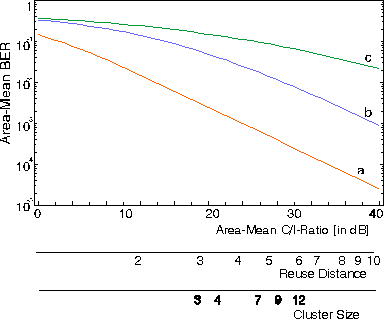
 |
JPL's Wireless Communication Reference WebsiteChapter: Analog and Digital Transmission
|
This allows us to find average bit error rates for a user at a worst case location, i.e., at a cell boundary. Note however that average bit error rates do not say so much about link performance. Bits occur in bursts and much depends on the error correction method, the interleaving and block size. Therefore, many operators rely on outage probabilities, instead of average bit error rates.

Figure: Average BER for BPSK, versus average C/I ratio; versus reuse distance and versus cluster size. Rayleigh fading. Shadowing: (a) 0dB, (b) 6 dB and (c) 12 dB.